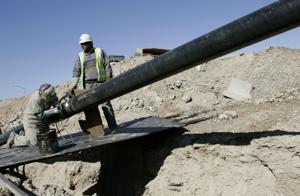

Too often, we take for granted the energy that powers our homes and vehicles and that is so essential to our daily lives. When consumers need it, it’s there.
The recent cyberattack on the Colonial Pipeline, which stretches from Texas to New Jersey, reminds us that energy infrastructure to deliver fuel to gas pumps and power plants is also essential. Though the ttack prompted panic buying and gasoline shortages in the nation’s southeast, the problem wasn’t one of production but rather a disruption in the supply chain.
The temporary, but crippling, closure of this cross-country pipeline underscores the critical nature of energy infrastructure, especially fuel pipelines that bring oil and natural gas from producing areas to refineries, processing facilities, and consumers.
As a top energy-consuming state and the nation’s second-largest net supplier of total energy to other states, Pennsylvania relies on more than 3,000 miles of liquid pipelines – along with over 10,000 miles of natural gas transmission pipelines – to securely transfer energy from the drilling rig to the gas pump, or for heating homes. Pipelines are the safest, most environmentally friendly way to transport oil and natural gas, and the products made from them, between states and major cities, including Philadelphia and its suburbs.
Pipelines have been essential to Pennsylvania’s energy revolution, too. With modern hydraulic fracturing and horizontal drilling of its abundant shale deposits, Pennsylvania has become the nation’s second-largest supplier of natural gas, prompting the construction of more pipelines to distribute energy from producing areas in the state’s southwest and northeast.
While natural gas production has boosted the Keystone State’s bottom line – generating billions in tax and impact-fee revenues and supporting hundreds of thousands of jobs – it has outpaced the development of the pipeline infrastructure required to deliver gas to plants and markets. In fact, natural gas supplied a record-high 40% of U.S. net electricity generation in 2020, according to the U.S. Energy Information Administration, and reduced carbon emissions from power generation to their lowest levels in a generation.
Transporting energy by pipeline is also cost-efficient compared with the alternatives. Consumers benefit from the lower cost when heating their homes or filling up their gas tanks. It costs roughly $5 per barrel to move natural gas and oil by pipeline, compared to $10 to $15 per barrel by rail and $20 per truck, according to an analysis by Strata. In addition, moving energy by pipeline cuts down on the number of trucks carrying fuel on the road, reducing congestion and helping to lower emissions in the transportation sector.
Pipelines play a crucial role in America’s energy revolution and security. Natural gas and oil development has sparked extraordinary job and economic growth and enabled America to shed its reliance on other nations for fuel. Our network of pipelines delivers domestic energy in a safe, efficient manner, ensuring that Americans have widespread access to affordable, reliable energy.
All of this helps explain why efforts to shut down pipeline projects in Pennsylvania and other states, including the Keystone XL and Line 5 pipelines, are so perplexing. The U.S. needs more pipelines to connect producing areas to refineries and chemical plants while delivering products that American consumers and businesses need. As our economy reopens and the demand for energy grows, we need more domestic energy production and pipeline infrastructure.
Pipeline projects like Keystone and others have become casualties of partisan politics and misinformation. Both consumers and pipeline workers have lost out.
Pipeline jobs are often union-affiliated careers with competitive, family-sustaining salaries. From 2013 to 2016, infrastructure development and maintenance supported nearly 1.2 million jobs. With investment in this critical infrastructure, pipelines will continue to contribute significantly to the nation’s economy, supporting an average of 800,000 to 1 million jobs each year through 2035. From 2015 to 2016, pipeline construction and operation produced a $31.8 billion increase in labor income and contributed $46.9 billion to GDP.
Americans understand the numerous benefits of pipelines. A recent survey of 3,000 U.S. consumers found 70% held a positive impression of pipelines – and their support is increasing. Most Americans don’t see canceling pipelines as a good way to combat climate change.
The recent disruption to the Colonial Pipeline’s operations demonstrates the strong demand for oil and natural gas and the critical role of pipeline infrastructure for delivering fuel. Now the world’s leading natural gas and oil producer, the U.S. must maintain and expand pipeline infrastructure to ensure widespread access to abundant, affordable, and reliable domestic energy. Halting pipeline projects not only puts thousands of people out of work but also weakens nation’s energy security and economic recovery.
* This article was originally published here
HELP STOP THE SPREAD OF FAKE NEWS!
SHARE our articles and like our Facebook page and follow us on Twitter!




0 Comments